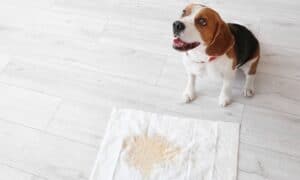“This post contains affiliate links, and I will be compensated if you make a purchase after clicking on my links.”

Dear Kevin,
Toby is a rescue & about 1.5 yrs old. Very needy dog. Previous owners showered the puppy (6wks) with love when they first got him since he was just a little fur ball. But once he grew they began to hate him. They were not home & had no yard to leave him in so he never got potty trained. They began to verbally abuse him until I took him away from them.
He is a poodle, not large, not miniature but about 10 lbs. He can be outside all day long but when he comes in the house, he pee’s any & everywhere. I only know to scold him & put him back outside. That is not working & from what I have read is not the way to train him. PLEASE PLEASE help!! I have carpet & he is ruining it. He is too small & too short hair to stay outside in winter but I need help.
Thanks so much for your time.
Hey there,
I want to start off by thanking you for giving Toby a loving home. I understand how frustrating it can be to have a dog that is not picking the appropriate places to eliminate. Typically the longer the dog has been rehearsing the unwanted behavior, the longer it will take to “break.” The goal is to teach him an entirely new behavior, which is eliminating outdoors.
In order to teach this new behavior you need to find something that Toby loves, like chicken, turkey, hot dog etc. The idea is to only use this reward when he makes the correct decision. (Eliminating outdoors.) Timing is very important when teaching this. Whatever that last behavior the dog has done is what you are rewarding. For instance, if he goes outside and urinates, you call him back to you, he comes, you tell him “good boy” and give him his food reward. What you are technically doing is rewarding him for coming back to you. This is one of the biggest mistakes people make when trying to teach this behavior. Going out with the dog is a must when teaching this. My advice is, as soon as the last drop hits the ground, a reward should be in the dog’s mouth. This will ensure that the dog knows what it is getting the reward for. As long as the reward is good enough, it will motivate Toby to continue to eliminate in that spot.
Setting Toby up for success is extremely important. If you don’t currently have a crate, I highly recommend getting one. The crate should be big enough for him to be able to stand on all fours and turn around. If the crate is any bigger it will give him enough room to eliminate in one side, and hang out in the other. If it is the proper size he shouldn’t eliminate because he won’t want to sit in his own mess. (Unless he is dealing with something else like separation anxiety.) Using a crate can be an excellent tool. The idea of it is to put him in there when he can’t be properly supervised, or if you think he has to go, but isn’t going. If everything goes to plan the crate gives you a safety cushion of guaranteed time where he is not eliminating.
I would throw punishment out the window on this. The best thing you will get from punishing this behavior is a dog that is afraid to eliminate in front of a human. If the dog is scared to eliminate in front of a human it makes it impossible for us to tell him where the correct place to go is.
How long would you say he can currently go in between eliminations? If the answer is an hour, for the next week give or take, I recommend getting him out every 45 minutes. If he is still having accidents within those 45 minutes, it will be important to get him out even more often. Once he is having success with that amount of time, start to increase the amount of time in between being let out. Make sure you increase the amount of time in small increments. If you increase the time too fast you will set him up for failure. For the record the general rule of thumb is for every month old a dog is, equals an hour they can hold their bladder.
I would start using play time outdoors as a reward for eliminating the proper spot as well. Meaning I wouldn’t let him out to play just so he can come in and eliminate. Use walks to your advantage. Typically on a walk a dog will get most of its elimination out of the way if it’s allowed to. I would also recommend regulating the water intake. I don’t think he is ready for a full bowl of water to be lying around at all times.
One last thing in regards to the crate: I use a system with the crate when I think the dog has to eliminate, but is not doing it. I will put the dog in the crate for 15 minutes or so. After that time I will let him directly outside to eliminate. If he goes, I will reward and then allow him the freedom of being in the house with me supervised. If he doesn’t eliminate I will put him back in the crate and wait another 15 minutes. (Repeat the cycle until you get the desired behavior.)
Another good idea is to use a tethering system. What I mean by this is his leash is tethered to your waist so you know where he is at all times. This system works for some, but not all. One other thing you could do is take him to see his veterinarian to rule out anything medical like a Urinary Tract Infection.
Thank you for the question!
Kevin Duggan CPDT-KA
Kevin is a Certified Professional Dog Trainer through the Certification Council for Professional Dog Trainers (CCPDT.org) and is a Canine Good Citizen Evaluator through the American Kennel Club. He currently resides in Ohio with his dog, V, a six-year-old Shepherd/Lab mix, where he operates All Dogs Go To Kevin, LLC, specializing in helping build positive relationships between humans and their canine companions using clear communication, not pain and fear. For more training tips and tricks, and to meet his amazing dog, V, follow him on Facebook by clicking here.
Do you have a tough training question of your own? Click HERE to “Ask the Trainer!”
























ANOTHER MENTION SHOULD BE, IN REFERENCE TO THE COLLAR ON THE DOG, I JUST READ OF A DOG, A YELLOW LAB, THAT WAS CRATED, SHE HAD HER COLLAR ON AND WAS PLACED IN THE CRATE, WHEN THE HUMAN RETURNED SOMEHOW THE LAB GOT HER COLLAR STUCK AND CHOKED TO DEATH! COMING HOME TO THAT WAS HEARTBREAKING TO READ ABOUT, I DON’T PUT MY DOGS HARNESS ON UNLESS HE IS GOING OUTSIDE, THEN ITS REMOVED WHEN WE COME INSIDE, HE HAS A CHIP, AND HIS DOG TAGS ARE ATTACHED TO HIS HARNESS! THANKS
Gina
says:Ooh,Sylvia….. I had the same problem that I couldn’t resolve with my otherwise almost perfectly trained dogs. I found a little aerosol can for training called ” the Pet Corrector”. It looks like a small traveling size hairspray can. Once they barked I sprayed it, away from them….. Actually out of their site (eventually they figured out the red can was the culprit of the hissing noise). It seemed to work, at first attempt. On our next outing, I usedit again, they quieted immediately again. The third outing, one barked once…. The other had a very quiet gggr, he wanted to bark and the third did not peep – just by seeing the can! I continued to bring it with me without needing to use. A week or so later they attempted to bark, until they saw the can. Perhaps it’s negative training. Yet, it’s miraculous. I didn’t use the whole can. It was effective after the first time. I did use it again …. And I did reward them, verbally and touching. I’m wondering if one could use a travel size hairspray and save a few bucks. Hairspray we’d spread in the wind tho and is not as loud. With this you don’t have to scold them to be quiet or shush. Although, they do know my ssshhh command and to this day, they are quiet. If they want to bark I hear an occasional gggrrrr, not even close to the riot before. I actually call this pet corrector a miracle! For barking, nearly instantaneous results and very little work…. Teaches them your quiet command as well.
Mary
says:Okay, I know you addressed this to the trainer and hopefully he will reply. But why are you using punishment and negative training with your dog? I also have a mini schnauzer. They are smart…but also stubborn, and ALL dogs respond better to positive training methods than punishment. Schnauzers do bark, it’s in their nature. My dog also will sometimes bark at people. But I’ve worked with a trainer to help walk her so that she will ignore people passing by. People approaching are sometimes seen as a threat, and that’s a different technique. You need help figuring out why your dog is barking (scared? nervous? reactive? wanting to greet the person? protecting you?) Get a good trainer to work with who uses positive methods and stop punishing your dog.
Sylvia Sankey
says:Dear Kevin,
We have a 3 1/2 year old mini-Schnauzer who barks at everyone when we are outside, even if he knows them. He also barks inside (at the people walking outside).
I really don’t know what to do. We’ve tried using a stern voice, scolding him and now we use a spray bottle of water (and some white vinegar) to train him. We never taught him to ‘speak’, but we would really like to be able to walk around the neighbourhood without constantly having to apologize to people.
He’s taken puppy and junior classes and has done very well in them.
He is very smart and knows when he is doing something wrong. For example, he used to lunge and go crazy when he saw other dogs. That has almost completely stopped (with the help of the spray bottle), so we know he can learn – he just doesn’t want to!
Thank you for any help you can give us.